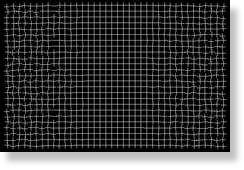Reasons why we see only what we expect to see. People tend to think of perception as a passive process. We see, hear, smell, taste or feel stimuli that impinge upon our senses. We think that if we are at all objective, we record what is actually there. Yet perception is demonstrably an active rather than a passive process; it constructs rather than records "reality." Perception implies understanding as well as awareness. It is a process of inference in which people construct their own version of reality on the basis of information provided through the five senses.

© Michael Michalko
In the illustration a grid appears normal in the center, yet the left and right areas are irregular and incoherent. If you stare at the center of the grid for a few minutes, the grid will miraculously heal itself and you will perceive a perfect grid. In reality, the grid is still incoherent but your mind will perceive it as a perfect grid. This is because your mind is strongly influenced by your past experiences, education, cultural values and role requirements as well as by the stimuli recorded by their receptor organs. Your mind expects the grid to be a perfect grid and makes it so.
Perception is also skewed by the observer's own expectations, assumptions and preconceptions.One classic experiment to demonstrate the influence of expectations on perception used playing cards, some of which were gimmicked so the spades were red and the hearts black. Pictures of the cards were flashed briefly on a screen and, needless to say, the test subjects identified the normal cards more quickly and accurately than the anomalous ones. After test subjects became aware of the existence of red spades and black hearts, their performance with the gimmicked cards improved but still did not approach the speed or accuracy with which normal cards could be identified.
This experiment shows that patterns of expectation become so deeply embedded that they continue to influence perceptions even when people are alerted to and try to take account of the existence of data that do not fit their preconceptions. Trying to be objective does not ensure accurate perception.
In the illustration, read the colors of the words aloud. The colors not the words.

© Psychology Today
This task is difficult, as I'm sure you've discovered. Not only is it difficult but it is resistant to practice. The difficulty of removing the interference effect of the words when trying to state the colors is because our brains are conditioned to recognize words without effort. In other words, people see the meaning or words without much effort or consciousness. On the other hand, naming colors is not automatic. It requires more effort than reading, thus creating interference in this simple task. Our pattern of the expectation of reading words is so deeply embedded it cannot be turned off and creates the interference with the task of naming colors.
The Implications for Intelligence and Governments The position of the test subject identifying playing cards is analogous to that of the intelligence analyst or government leader trying to make sense of the paper flow that crosses his or her desk. What is actually perceived in that paper flow, as well as how it is interpreted depends in part, at least, on the analyst's patterns of expectation. Intelligence analysts do not just have expectations about the color of hearts and spades. They have a set of assumptions and expectations about the motivations of people and the processes of government in foreign countries. Events consistent with these expectations are perceived and processed easily, while events that contradict prevailing expectations tend to be ignored or distorted in perception. Of course, this distortion is a subconscious or pre‑conscious process.
This tendency of people to perceive what they expect to perceive is more important than any tendency to perceive what they want to perceive. In fact, there is no real tendency toward wishful thinking. The commonly cited evidence supporting the claim that people tend to perceive what they want to perceive can generally be explained equally well by people see what they expect to see.
Thought Experiments Look at the illustration. Do not read further content until you guess as to what the illustration might represent.

© Unknown
Expectations have many diverse sources, including past experience, professional training, and cultural and organizational norms. All these influences predispose us to pay particular attention to certain kinds of information and to organize and interpret this information in certain ways. Perception is also influenced by the context in which it occurs. Now, suppose I tell you the illustration contains the face of a cow. Can you find it? You will find it if you expect to find it.
Patterns of expectations tell us, subconsciously, what to look for, what is important, and how to interpret what is seen. These patterns form a mind‑set that predisposes the black and white spaces to organize themselves in such a way that you can perceive the face of a cow. This perception is formed on the basis of very little information (i.e., you were told the illustration contained the picture of a cow.).
Once people form impressions on the basis of very little information, they do not reject or change them unless they obtain rather solid evidence. The early but incorrect impression tends to persist because the amount of information necessary to invalidate a hypothesis is considerably greater than the amount of information required to make an initial interpretation. The problem is not that there is any inherent difficulty in grasping new perceptions or new ideas, but that established perceptions are extremely difficult to change.
I promise you that every time from now on you see this illustration, you will immediately see the face of the cow.
Michael Michalko is the author of Creative Thinkering, Thinkertoys
(A Handbook of Creative Thinking Techniques), Cracking Creativity,
and ThinkPak
(A Brainstorming Card Deck). While an army officer, he organized a team of NATO intelligence specialists and international academics to find and collect the best inventive thinking methods and techniques in the world.
Reader Comments
I saw no cow either until I highlighted the image and accompanying text. There's a description of my perception of the cow along with some article commentary (which prolly tells more about my psychology than the article) at this [Link], if anyone is interested.
The reason: "When tasting what they think is good wine, they are looking at what is good about it and ignore all the rest(there mind does it automatically based on expectations), when tasting what they think is cheap wine, they are looking at what is bad about it and ignore everything that is good(again without conscious awareness)."
Implication: Wine prices are determined by 'wishful thinking' more than quality, because the quality for the most part is illusory as demonstrated in many many experiments.
Another experiment: They take good high quality wine and poor low quality wine, serve them up and hand out the glasses to experts and non-experts. This time they don't know what is good and what isn't. They show that the experts aren't so expert after all since they have nothing to base there expectations on whilst naive people can say with better accuracy what is the expensive wine and what is the cheap wine since they have no expectations as they don't know much about wine.
Implication: Expectation can cause havoc especially to those who claim great knowledge if they somehow can't find a way to balance it off with a sort of youthful naivety!
Is it trying to tell us that we are all just fooling ourselves and there is nothing we can do about it?
Is it trying to tell us that we can't trust our own perceptions, and thus should rely on the interpretation of an authority figure?
Possible counter-facts:
1) There are more than just 5 senses. And they combine to perceive from 12 to over 50 different types of perception, depending on who is making the list.
2) If one can have expectations and preconceptions, it follows that one could become aware of them and learn to overcome them.
3) You might as well learn to trust your own perceptions, because the other guy's could be twice as twisted as yours are.
I tend to agree with the problem of government intelligence. Probably not worth the money we spend on it.
Luke said:
Implication: Expectation can cause havoc especially to those who claim great knowledge if they somehow can't find a way to balance it off with a sort of youthful naivety!
Me:
Wonderful way to put it! The combination of seeing like an artist (youthful naivety) and the scientist's (great knowledge) yields the alchemist (whole person), OSIT.
all object consciousness is the result of mental conditioning. Upon examination it seems clear that nothing can be objectively verified, as mind hangs itself by its bootstraps.
No cow, no perfect grid.
Did anyone see a perfect grid or a cow?
I see the cow clearly.
The grids did "fix" themselves, and the cow did not appear until I learned there was one in the picture.
Am I the only one who found the color/name test not at all difficult?
@Gluttony, the colour test wasn't as hard as the author put it(maybe it's the presentation that let the test down?), other people have mentioned the same.
The grid doesn't fix itself, I think its more perspective because when you concentrate on the center the distortions on the edges become less apparent.